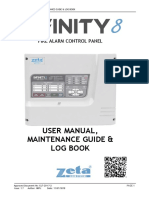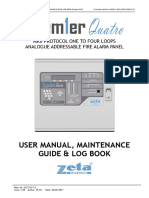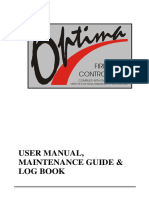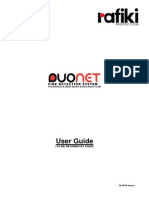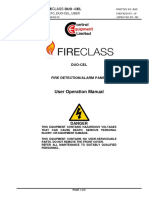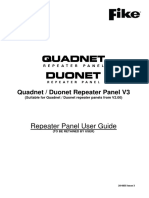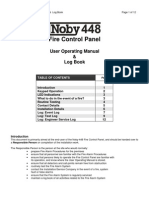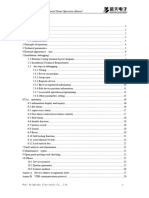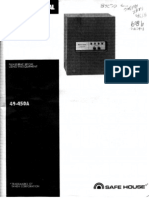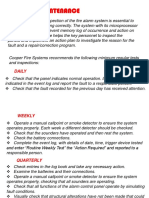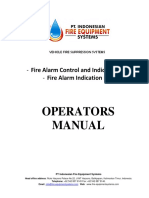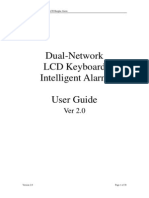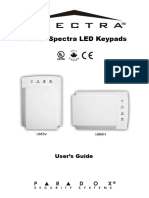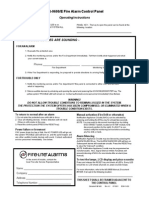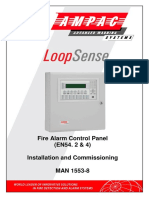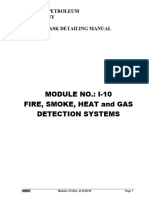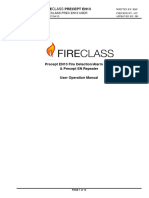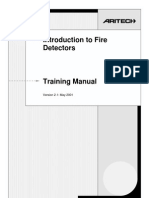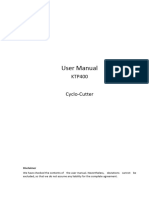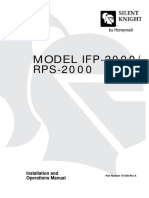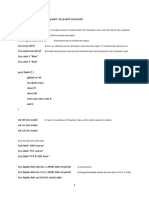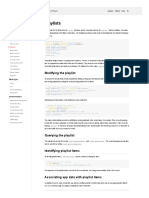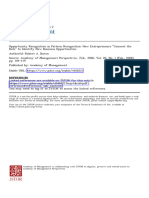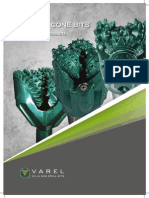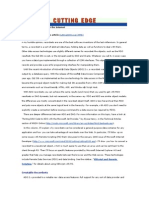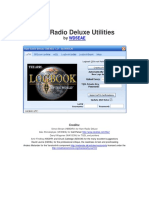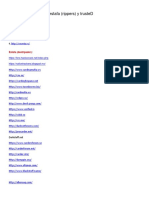NPAD V2 User Manual
NPAD V2 User Manual
Uploaded by
Mohamed ShobatCopyright:
Available Formats
NPAD V2 User Manual
NPAD V2 User Manual
Uploaded by
Mohamed ShobatOriginal Description:
Copyright
Available Formats
Share this document
Did you find this document useful?
Is this content inappropriate?
Copyright:
Available Formats
NPAD V2 User Manual
NPAD V2 User Manual
Uploaded by
Mohamed ShobatCopyright:
Available Formats
USER MANUAL , MAINTENANCE GUIDE & LOG BOOK
PREMIER AD USER MANUAL, MAINTENANCE GUIDE & LOG BOOK
CONTENTS What to do if the Fire Alarm Panel shows an Alarm (Red LED) ............................................................ 2 What to do if the Fire Alarm Panel shows a Fault (Yellow LED) ........................................................... 2 1. FIRE ALARM CONTROL PANEL SAFETY ISSUES ........................................................................ 3 2. THE PURPOSE OF A FIRE ALARM SYSTEM ................................................................................. 3 3. USER RESPONSIBILITIES & MAINTAINENCE OF THE FIRE ALARM SYSTEM, INCLUDING THE FACP & ITS INTEGRAL PSE ........................................................................................................ 4 4. PANEL INDICATIONS & CONTROLS .............................................................................................. 5 4.1 INDICATIONS ............................................................................................................................. 5 4.2 CONTROLS ................................................................................................................................ 5 4.3 ACCESS LEVELS ....................................................................................................................... 6 4.4 CHECKING THE PANELS INDICATION LEDS ......................................................................... 6 4.5 WHAT THE LEDS MEAN ............................................................................................................ 6 5. THE FIRE CONDITION ..................................................................................................................... 7 5.1 HOW THE PREMIER AD INDICATES AN ALARM .................................................................... 7 5.2 TO TURN OFF THE ALARM SOUNDERS ................................................................................. 7 5.3 A SECOND ALARM SIGNAL FROM A NEW DETECTION ZONE ............................................ 7 5.4 TURNING ON THE ALARM SOUNDERS FROM THE FACP (I.E. TO EVACUATE THE BUILDING). ....................................................................................................................................... 7 5.5 RESETTING THE PANEL ........................................................................................................... 7 6. THE FAULT CONDITION .................................................................................................................. 8 6.1 DIFFERENT TYPES OF FAULT ................................................................................................. 8 6.2 WHAT TO DO IF A FAULT CONDITION OCCURS ................................................................... 9 6.3 OTHER LED INDICATIONS ....................................................................................................... 9 7. DISABLEMENTS ............................................................................................................................. 10 7.1 REASONS FOR DISABLING CERTAIN PARTS OF A FIRE ALARM SYSTEM. ..................... 10 7.2 TO DISABLE A ZONE AND/OR EXTERNAL SOUNDERS. ..................................................... 10 7.3 TO ENABLE A ZONE AND/OR EXTERNAL SOUNDERS. ...................................................... 10 8. SYSTEM DESCRIPTION ................................................................................................................ 11 FIRE ALARM SYSTEM SUMMARY: .............................................................................................. 11 DETAILED LOOP CONTENTS ....................................................................................................... 12 10. FIRE ALARM LOG BOOK ............................................................................................................. 14 MAINTENANCE WORK .................................................................................................................. 15 FALSE ALARMS ............................................................................................................................. 16 ALL EVENTS OTHER THAN MAINTENANCE WORK OR FALSE ALARMS................................ 17 11 COMMISSIONING THE SYSTEM, INCLUDING P.S.E. ................................................................ 18 11.1 DESIGN, INSTALLATION & COMMISSIONING CERTIFICATES ......................................... 18 Design Certificate ............................................................................................................................ 19 Installation Certificate ...................................................................................................................... 21 Commissioning Certificate............................................................................................................... 22 Acceptance Certificate .................................................................................................................... 23
Approved Document No: GLT.MAN-106A Issue: 2.00 Authorised: GH Date: 16/07/2007
PAGE 1
PREMIER AD USER MANUAL, MAINTENANCE GUIDE & LOG BOOK
What to do if the Fire Alarm Panel shows an Alarm (Red LED)
Write down the LCD reading and which LEDs are lit (either in the log book, or on a piece of paper for transferring to the log book later) Follow the building procedures for fire alarm activation. When the building has been evacuated, the sounders can be silenced by turning the key to the on position and pressing the Start/Stop Sounder button, then pressing the Silence Tone button. (Note that the sounders may take up to 8 seconds to stop) If there is no sign of fire, investigate the area that reported the fire CAREFULLY. Check for a detector or a call point with its RED LED lit. If a detector caused the alarm, look for any innocent phenomena that could have activated it (Steam, cooking food, exhaust smoke, excessive dust etc can all activate a smoke detector.). If anything is found, try to clear the room by opening a window. If a fire is discovered, either tackle it with fire extinguishers if suitably trained, or call the fire brigade. To reset the panel press the reset button. If the panel goes back into alarm, silence the sounders and call the engineer.
What to do if the Fire Alarm Panel shows a Fault (Yellow LED)
Write down the LCD reading and which LEDs are lit (either in the log book, or on a piece of paper for transferring to the log book later) If the supply fault LED is lit, check if there is a power cut to the building. Check that the mains supply to the fire alarm has not been turned off. If the Prealarm LED is on, this could be either a detector that needs servicing, or the start of a fire (or other phenomena that can activate the detector). Investigate the indicated location and take appropriate action. All other fault indications will need the service engineers attention. Call the engineer as soon as possible. Note that when the alarm is in a fault condition, the majority of the system will still function correctly. Extra vigilance should be paid in the area with the fault. The alarm may not be operational in this area. The panel`s internal buzzer can be silenced by turning the key to the on position and pressing the Silence Tone button. If the fault comes and goes, the panel will buzz every time the fault happens. If this is not acceptable you may be able to disable the zone that has the fault. (see page 11)
Approved Document No: GLT.MAN-106A Issue: 2.00 Authorised: GH Date: 16/07/2007
PAGE 2
PREMIER AD USER MANUAL, MAINTENANCE GUIDE & LOG BOOK
1. FIRE ALARM CONTROL PANEL SAFETY ISSUES
There is no need to open this fire alarm during normal operation. Any work carried out on this system must be performed by a competent person who is familiar with this type of system. This equipment will operate safely provided it has been installed correctly in compliance with the Installation Manual. It is recommended that the system is serviced frequently. It is customary to arrange a regular maintenance contract with a competent organisation. (Ask the installation company for recommendations). The system needs a thorough maintenance check annually at the very minimum. If any part of this Fire Alarm Control Panel becomes damaged, contact the company responsible for system maintenance to arrange repair / replacement. CE European Union Directives Conformance Statement This product has been manufactured in conformance with the requirements of all applicable EU Council Directives. The Declaration of Conformance for this product is located at the following Address: GLT Exports Ltd, 72-78 Morfa Road, Hafod, Swansea, SA1 2EN, United Kingdom
2. THE PURPOSE OF A FIRE ALARM SYSTEM
A Fire Alarm System is used to provide an early warning of a fire, so that the property can be evacuated and the fire extinguished if it can be safely tackled, or the local fire brigade called, according to the company evacuation procedure. Alarms can come from Smoke or Heat Detectors, or manually by a person operating a Manual Call Point. Splits the building into Zones, each covering a different area of the building. This will indicate which area of the system is giving the alarm (or fault). During an alarm, the panel will start its sounders, and indicate which zone has the fire. It will also activate its auxiliary relay. Fault Monitoring The panel checks all circuits for line integrity. If a part of the system has a problem, which may affect its operation, a fault warning must be given by the fire alarm panel (LED & buzzer indication). The fault relay will also activate. Disablements An engineer may be required to work on part of a system, while the system is still active (eg extending a detection zone). During such circumstances, it would be advisable to disable that zone, so that it will not give false alarms. Similarly you may wish to disable a zone that has a fault that has not been fixed, or a zone covering an area with a temporary unusual environment, such as an area which is dusty because of construction work etc. Power Supply Equipment- General Description. The NPAD FACP has an integral linear power supply capable of supplying 1.5 amps in total. It contains a current limited output for charging sealed lead acid batteries (7 Ah maximum). The PSE is monitored for main supply failure, the battery not taking a charge and low battery voltage. If the battery voltage drops below approximately 20VDC (a fault condition), the battery charging current will be turned off , thus stopping charging. This PSE is only capable of supplying power to the CIE, and is not designed for any other use.
Approved Document No: GLT.MAN-106A Issue: 2.00 Authorised: GH Date: 16/07/2007
PAGE 3
PREMIER AD USER MANUAL, MAINTENANCE GUIDE & LOG BOOK
3. USER RESPONSIBILITIES & MAINTAINENCE OF THE FIRE ALARM SYSTEM, INCLUDING THE FACP & ITS INTEGRAL PSE
According to the British Standard Code for Fire Detection and Alarm Systems for Commercial Buildings (BS5839: Pt 1: 2002), the owner or person having control of the premises should appoint a responsible person to oversee the effective operation of the Fire Alarm System (Clause 47.1). Below is a summary of the main functions the Responsible Person is expected to carry out. This summary is not intended to replace Section seven (User responsibilities) of BS5839: Pt 1: 2002 (available from BSI, or your local library). It is meant to give a brief outline of user responsibilities for the safe upkeep of the Fire Alarm System. The number in brackets shows the relevant BS5839: Pt 1: 2002 clauses. The responsible person must:Have sufficient authority to carry out the duties associated with being the responsible person (47.2.a) Check the system at least once every 24 hours to ensure there are no faults present (47.2.b) Ensure there are arrangements for testing and maintaining the system (47.2.c) Ensure the log book is up to date, and available for inspection (47.2.d) Instruct all relevant occupants on the basic operation of the system, including start evacuation, silence alarms, silence faults and system reset (47.2.e) 6. Take appropriate action to limit the rate of false alarms (47.2.f) 7. Ensure that all detectors and manual call points remain unobstructed at all times (47.2.g) 8. Liase with maintenance personnel to ensure that cleaning, maintenance or building work does not interfere with the functioning and reliability of the fire alarm system (47.2.h). 9. Ensure any changes to the system are recorded with updated drawings, operating instructions etc (47.2.i) 10. Ensure that there are spare parts (especially Call point elements) held on site (47.2.j.1&2) 11. In the event of a prealarm, determine the cause & take appropriate action (predetermined fire routine if the cause is the start of a fire, arrange maintenance if the cause is a contaminated detector head) (47.3) With the Premier AD Fire Alarm Panel, we recommend the following tests are carried out: Daily Inspection Check that the green Power LED is lit. If there are any yellow fault LEDs lit, or the green Power LED is not lit, report the fault(s) to the designated site maintenance engineer. Weekly Test (you may wish to temporarily disconnect the Aux relay during the following Tests) Set off a manual call point or sensor to test the Fire Alarm panel responds and all the sounders activate. Do not test the same device each week. Test a different zone each week using a different call point or detector so that eventually, all the devices will be tested. Reset the System by pressing 1,2,3 (Stop sounders, Silence fault tone, Reset). Turn key to controls enabled. Press the LED Test button. Check that all LEDs light, and the buzzer sounds Check that no call points or fire detectors are obstructed in any way. (eg New furniture or decorations) Quarterly Test (to be carried out by authorised service personnel only) Check that any servicing or repairs required by all previous logbook entries has been undertaken. Visual inspection of the batteries and connections. Check the alarm sounders work on battery only. Activate a device from each zone to test the fire alarm. (As per weekly test). Annual Test (to be carried out by authorised service personnel only) Check every detector, call point, sounder and all auxiliary equipment for correct operation. Check Transformer output Voltage (32 VAC), Charger Voltage (28.4V off load, adjusted with VR1) & Battery Voltage (25-27V) Every Five Years (to be carried out by authorised service personnel only) Carry out a complete wiring check in accordance with the testing and inspection requirements of the relevant National wiring regulations (in the UK this is the IEE Wiring Regulations). The Batteries should be replaced because SLA batteries have a working life of 5 years. 1. 2. 3. 4. 5.
Approved Document No: GLT.MAN-106A Issue: 2.00 Authorised: GH Date: 16/07/2007
PAGE 4
PREMIER AD USER MANUAL, MAINTENANCE GUIDE & LOG BOOK
4. PANEL INDICATIONS & CONTROLS
4.1 INDICATIONS The Premier AD has been designed to be as straight forward as possible. To help achieve this it has been designed so that its LEDs are the primary display. Every possible fault has its own unique LED. Each LED is used to represent only one condition. This helps avoid the confusion caused when a single LED is used for 2 or more conditions. The LCD is used during setup, and to give detailed information about zone faults.
IN THE EVENT OF AN ALARM
After the site has been deemed safe for return, to return the panel to normal: 1. Turn keyswitch to Controls Enabled position. 2. Press Stop/Start = turn off external sounders 3. Press Silence = turn off the panels buzzer 4. Record the LCD details in the Fire Alarm Log Book 5. Press Reset = return panel to normal condition.
4.2 CONTROLS The controls on the Premier AD are grouped together to try to be as user friendly as possible. The Silence, Reset & Start/Stop Sounder buttons are the main control buttons. Silence = turn off the panels buzzer Stop/Start = turn off external sounders Reset = return panel to normal condition. To silence a panel after an alarm, press Stop/Start, followed by silence. Record the LCD details in the log book, then press Reset. The previous & Next buttons by the LCD are used to scroll between fault messages. The next button is also used in the Device Status Menu. The Test function Confirm, Test & Select buttons are used to control the one man test mode. The Disablement Select, Confirm & Disable are used to select panel section disablements. The numeric section is for entering access codes, and for entering device addresses. The alphabet keys are used to enter device labels in the programming menu. The remaining 5 buttons are miscellaneous items, each ones function is clearly labelled.
Approved Document No: GLT.MAN-106A Issue: 2.00 Authorised: GH Date: 16/07/2007
PAGE 5
PREMIER AD USER MANUAL, MAINTENANCE GUIDE & LOG BOOK
4.3 ACCESS LEVELS The Premier AD has the following access levels i. QUIESCENT STATE When the Panel is in its Normal state, the indicator lights on the front of the enclosure give a comprehensive overview of the Systems current status. Any Fire and Fault conditions are clearly displayed, and any disablements highlighted. For detailed descriptions of what each indicator means, please refer to the table on the opposite page. The only functions that can be performed by the User when the Panel is in its Normal state are:
ii.
Scrolling between faults & alarms using the Previous & Next buttons. Putting the Panel into the Controls Enabled state see below. CONTROLS ENABLED This access level is obtained by turning the keyswitch to the controls enabled position. Here the user can start or stop the external sounders, silence the panels internal buzzer, or reset the panel. The numeric keypad is also enabled which allows the user to enter the codes for configuration or test modes.
iii.
CONFIGURATION MENU FOR INSTALLATION /COMMISSIONING ENGINEER ONLY This access level is obtained by entering the configuration code. This is a factory preset code which cannot be changed (see Installation Manual). Here the user can View loop contents, read individual devices, edit the messages for each device, or reconfigure the panel. (Select Covered to exit the menu)
iv.
TEST MODE SELECTION FOR TEST ENGINEER ONLY This access level is obtained by pressing the test button, and entering the test code. This is a factory preset code which cannot be changed. Here the user can put any of the zones or sounder circuits into test mode. Turn the keyswitch back to the off position to exit this mode.
4.4 CHECKING THE PANELS INDICATION LEDS Turn the key switch to Controls Enabled position then press the LED test button . All the LEDs on the front panel will light for 3 seconds, and the panels internal buzzer will also sound. 4.5 WHAT THE LEDS MEAN The LEDs on the Premier AD can be grouped into the following sections: General Indications: These are indications to specific conditions, such as power, power supply faults, Earth faults, double address, system fault etc. They indicate all conditions except those that relate to the zones & sounders. Common Indications: These are Common Fire & Common Fault. These light in conjunction with another LED which indicates the fire or fault condition, as a backup indication. They do not represent a specific event. Zone Indications: These are used to show a fire, fault, test mode, or disablement on a zone. Note that the zone does not necessarily refer to a specific section of cabling. It refers to the address set to the devices. External Sounder Indications: These are used to show the state of the external sounder circuits. They can be active, in fault, in test mode, or disabled. Mode Indications: These are used to show which mode the panel is in. The controls active LED shows if the controls are enabled. The general Test & general disablement are used to indicate test mode & disablement mode respectively.
Approved Document No: GLT.MAN-106A Issue: 2.00 Authorised: GH Date: 16/07/2007
PAGE 6
PREMIER AD USER MANUAL, MAINTENANCE GUIDE & LOG BOOK
5. THE FIRE CONDITION
5.1 HOW THE PREMIER AD INDICATES AN ALARM
When the Premier AD Fire Alarm Panel is set into alarm by a Detector or Manual Call Point located in a zone that is not already in alarm it will: -
Light the General Fire LED and appropriate Zone Fire LED(s) on the front of its enclosure Sound Internal buzzer Start the Alarm Sounder and Auxiliary output, (provided there is no Delay set on the sounders). The building evacuation procedure should now be followed. IMPORTANT NOTE: If a zone has been disabled, it can not be triggered into Alarm. This should be remembered when disabling part of the system. (see Disabling zones or sounders later in this manual).
5.2 TO TURN OFF THE ALARM SOUNDERS
The Alarm Sounders may be silenced by turning the control key to Control Enable position and momentarily pressing the Start/Stop button.
The Alarm Sounders will cease to sound* but the light(s) for the Zone(s) in Alarm and the red General Fire light will stay lit. The Auxiliary Fire relay will remain active. (The Panels internal buzzer can also be silenced by pressing the Silence int flt button (button 2)). *Addressable loop sounders will stop within 2 seconds. Sounder bases can take up to 8 seconds to stop. If the START/STOP button is pressed again during this time, the panel will start the sounders again. 5.3 A SECOND ALARM SIGNAL FROM A NEW DETECTION ZONE If another detection Zone is activated after the Alarm Sounders have been silenced, the panel will: -
Restart the sounders Light the Zone Fire LED(s) for any new Zone(s) in alarm Keep the light(s) for the previous Zone(s) in fire, and General Fire lit.
5.4 TURNING ON THE ALARM SOUNDERS FROM THE FACP (I.E. TO EVACUATE THE BUILDING).
With the control key in Controls Enabled position, momentarily pressing the Start/Stop will cause the Alarm sounders to sound. Pressing the Start/Stop button again will Silence the Alarm Sounders. Note: If the Alarm Sounders have been disabled, pressing the Stop/Start button will have no effect.
5.5 RESETTING THE PANEL
Check the cause of the alarm activation. If the cause of the alarm was an activated call point, reset it (if resettable type), or fit a new glass element (if glass type). If the cause of the alarm was by detector activation (eg cooking smoke), the smoke will have to be cleared from the room before the panel can be reset. Reset the panel by pressing the reset button (3) after the sounders and panel buzzer have been silenced. If the call point is still active, or the detector is still smoky, this will cause another alarm straight after the panel is reset, and the alarm bells will start again.
Approved Document No: GLT.MAN-106A Issue: 2.00 Authorised: GH Date: 16/07/2007
PAGE 7
PREMIER AD USER MANUAL, MAINTENANCE GUIDE & LOG BOOK
6. THE FAULT CONDITION
6.1 DIFFERENT TYPES OF FAULT The fire alarm monitors itself, and any equipment connected to it, for any faults that can occur. If a fault occurs, the Panel responds by activating its Internal buzzer and lighting the General Fault light and any other Fault light(s) relevant to the particular fault. The panel will also display the fault on its LCD display. The Panels Fault relay will also activate. Typical faults are described below: Zone Fault The relevant Zone Fault light flashes when there is a wiring problem on a Zone or detector has been removed from its base. It should be noted that any alarms raised on the fault zone(s) may not be recognised by the Fire Alarm Panel until the Fault Conditions have been cleared. It can take up to10 seconds from repairing a fault for the display to clear.
LED ON LED OFF
*** Device Fault *** 1 of 1 Floor 1 Room 101 Zone:01 Lp:1 Ad:001
Power Supply Fault The Premier AD has 3 separate LEDs to help pinpoint the source of the problem. Battery Fault indicates that there is no battery connected to the panel. Charger Fault indicates there is a problem with the mains supply (or one of its fuses). Low Battery indicates that the battery voltage has dropped below 21 volts, and that these batteries are no longer working. If the mains supply fails, the panel will only operate for the standby period dictated by the size of the batteries fitted. If the batteries or charger fails at the same time as the Mains, the Panel will be inoperative.
***
LED ON LED OFF
FAULT *** 1 of 1
Mains/Charger Fail *** FAULT *** 1 of 1
Battery Fault
System Fault The System Fault LED lights when the Panels micro-processor has Reset, typically after excessive electrical interference, or if the contents of its memory have been corrupted. This fault can only be cleared by turning the key switch from off position to control enable position and then back to the off position again. If the fault re-occurs within 1 hour, this is indicative of a corrupt memory and expert advice should be sought. Note that leaving the memory write enable switch on also lights system fault as a warning to turn the switch off.
LED ON LED OFF
*Due to the nature of a System Fault (CPU not running correctly), the exact contents of the display can not be determined. It could be blank, filled with squares, garbled, or even say system normal if the CPU has re-started correctly.
Approved Document No: GLT.MAN-106A Issue: 2.00 Authorised: GH Date: 16/07/2007
PAGE 8
PREMIER AD USER MANUAL, MAINTENANCE GUIDE & LOG BOOK
Earth Fault The Earth Fault LED lights when the panel detects an earth fault (short circuit to earth) on the wiring to any part of the control panel. The panel will function correctly with a single earth fault, but if a second fault occurs it could damage the panel. The screen will show Positive or Negative to help the engineer locate the problem.
LED ON LED OFF
***
FAULT *** 1 of 1
Earth Fault Pos
Sounder Fault The Premier AD has Fault LEDs for each conventional sounder circuit & its Loop Powered sounders. The screen will show Sounder Open if there is an open circuit fault (Check fuse & end of line). The screen will show Sounder Short if there is a short circuit fault (Check cabling, device polarity & end of line). If there is a fault on the loop sounders, the line sounder fault LED will light along with the zone that contains that sounder.
LED ON LED OFF
***
FAULT *** 1 of 1
Sounder 1 Open
6.2 WHAT TO DO IF A FAULT CONDITION OCCURS If a fault occurs, the responsible person should:
Turn keyswitch to Controls enabled and press silence flt tone button to silence the fault buzzer. Write down the fault (s) in the Log Book at the back of this Manual. Take appropriate action to correct the fault (Usually by contacting the service engineer)
On the Premier AD panel, the fault indications (except system fault) are non latching. That is, when the fault has been cleared, the fault indication will turn off. When all faults have been cleared, the panel will return to its quiescent (normal) condition. When a fault has been rectified the indicator light for that Fault is automatically turned off. If all Faults are cleared, the General Fault light will go out and the Panels Internal Sounder will be silent (if not already muted). 6.3 OTHER LED INDICATIONS DISABLEMENTS TEST MODE
Approved Document No: GLT.MAN-106A Issue: 2.00 Authorised: GH Date: 16/07/2007
PAGE 9
PREMIER AD USER MANUAL, MAINTENANCE GUIDE & LOG BOOK
7. DISABLEMENTS
7.1 REASONS FOR DISABLING CERTAIN PARTS OF A FIRE ALARM SYSTEM. Certain parts of this Fire Alarm Panel can be temporarily disabled (i.e. switched off) to suit prevailing conditions. For example, if there is a risk of a False Alarm in a zone, for example, from vehicle exhaust smoke in a loading bay, it is possible for the user to disable that zone during the risk period and then enable it again afterwards. During a disablement of a zone(s), no fire or fault signal will be processed for that zone(s). Only zone(s) in a non-alarm state can be disabled, that is zones already in a fire condition cannot be disabled. External sounders can also be disabled as could be required in certain conditions. 7.2 TO DISABLE A ZONE AND/OR EXTERNAL SOUNDERS.
1. 2.
Insert and turn control key to enabled position; Press DISABLE button and the screen will show: ZONE DISABLEMENT ZONE 1. The panel is now in SELECT DISABLEMENT MODE.
Zone Disablement Zone 1 Enabled Single Devices: 0
3.
Press DISABLEMENT SELECT until the required zone or Zone Disablement sounder circuit is DISPLAYED. Press DISABLEMENT Zone 3 CONFIRM button. The screen will now show that the zone is Disabled disabled, and the Zone or Sounder LED will come on steady, along with the GENERAL DISABLEMENT LED. Single Devices: 0 This section is now disabled. (NOTE: Call points in this zone will still be active. Contact the engineer if call points need to be disabled) If more than one zone (or sounder) needs to be disabled, then press DISABLEMENT SELECT again until the required zone (or sounder) is selected. If the panel needs to be taken out of SELECT DISABLEMENT MODE (eg to silence a fault on another part of the system), Either press DISABLEMENT button, or turn the keyswitch off, then back on again. Once all the maintenance work has been done the zones need to be enabled again. If the panel is still in SELECT DISABLEMENT MODE, jump to paragraph 7, otherwise, turn the keyswitch to controls enabled, press DISABLE button. The panel is now in SELECT DISABLEMENT MODE Press the DISABLEMENT SELECT button until the disabled zone is displayed on the screen. Press DISABLEMENT CONFIRM button to de-select disablement. Scroll to any other disabled zone and enable in the same way. When all zones are enabled again, the GENERAL DISABLEMENT LED will turn off. Turn the keyswitch to off position to return the system to normal.
4. 5. 6.
7.
7.3 TO ENABLE A ZONE AND/OR EXTERNAL SOUNDERS. 1. Turn key to Controls enable position (since a zone is already disabled at this time, the General Disablement LED with stay lit (steady);
2.
2. 3.
Press DISABLE button and the screen will show: ZONE DISABLEMENT ZONE 1. The panel is now in SELECT DISABLEMENT MODE.
Press SELECT until the disabled Zone or sounder is shown. Press CONFIRM to enable the selected item. The screen will now show enabled, and its disablement LED will turn off. The General Disablement LED will also turn off after all sections are taken out of disablement. Turn control Key to Off position and this will return the panel to normal operation.
4.
Approved Document No: GLT.MAN-106A Issue: 2.00 Authorised: GH Date: 16/07/2007
PAGE 10
PREMIER AD USER MANUAL, MAINTENANCE GUIDE & LOG BOOK
8. SYSTEM DESCRIPTION
FIRE ALARM SYSTEM SUMMARY:
FIRE ZONE INFORMATION ZONE ZONE DESCRIPTION NUMBER A brief description of all the rooms and areas contained in each zone 1 2 3 4 5 6 7 8 9 10 11 12 13 14 15 16 Sounder SOUNDER CIRCUIT DESCRIPTION Circuit A brief description of all the rooms and areas contained in each circuit Circuit 1 Circuit 2 Circuit 3 Circuit 4 Any Other Information about The Sounder Circuits QTY SNDR QTY MCP QTY HEADS
QTY SNDR
QTY BELLS
OUTPUT ROUTING INFORMATION TYPE OF OUTPUT CONNECTED Auxiliary Output Yes/No Fault Output Yes/No
WHAT HAPPENS WHEN ACTIVATED
ADDITIONAL INFORMATION Any additional information the User needs to know about should be inserted into this box including details of the routing of any additional outputs, details of inputs utilised, etc.
THE INFORMATION ABOVE WAS COMPLETED BY
NAME: COMPANY: POSITION: DATE: _______________________________________________________________________________________ _______________________________________________________________________________________ _______________________________________________________________________________________ _______________________________________________________________________________________
Approved Document No: GLT.MAN-106A Issue: 2.00 Authorised: GH Date: 16/07/2007
PAGE 11
PREMIER AD USER MANUAL, MAINTENANCE GUIDE & LOG BOOK
DETAILED LOOP CONTENTS This must be fully recorded by an authorised Engineer before system handover.
INSTALLATION LOCATION:
ADDR ZONE TYPE LABEL ADDR ZONE TYPE LABEL ADDR ZONE TYPE
LOOP 1
LABEL
1 2 3 4 5 6 7 8 9 10 11 12 13 14 15 16 17 18 19 20 21 22 23 24 25 26 27 28 29 30 31 32 33 34 35 36 37 38 39 40 41 42
1 1 1 1 1 1 1 1 1 1 1 1 1 1 1 1 2 2 2 2 2 2 2 2 2 2 2 2 2 2 2 2 3 3 3 3 3 3 3 3 3 3
43 44 45 46 47 48 49 50 51 52 53 54 55 56 57 58 59 60 61 62 63 64 65 66 67 68 69 70 71 72 73 74 75 76 77 78 79 80 81 82 83 84
3 3 3 3 3 3 4 4 4 4 4 4 4 4 4 4 4 4 4 4 4 4 5 5 5 5 5 5 5 5 5 5 5 5 5 5 5 5 6 6 6 6
85 86 87 88 89 90 91 92 93 94 95 96 97 98 99 100 101 102 103 104 105 106 107 108 109 110 111 112 113 114 115 116 117 118 119 120 121 122 123 124 125 126
6 6 6 6 6 6 6 6 6 6 6 6 7 7 7 7 7 7 7 7 7 7 7 7 7 7 7 7 8 8 8 8 8 8 8 8 8 8 8 8 8 8
Pre-Commissioning Cable Checks +ve in to +ve out less than 24 ohms +ve to ve greater than 500k ohm -ve to Earth greater than 1M ohm.
-ve in to -ve out less than 24 ohms +ve to Earth greater than 1M ohm. +ve to ve less than 50 mV pickup (AC & DC)
Approved Document No: GLT.MAN-106A Issue: 2.00 Authorised: GH Date: 16/07/2007
PAGE 12
PREMIER AD USER MANUAL, MAINTENANCE GUIDE & LOG BOOK
This must be fully recorded by an authorised Engineer before system handover.
INSTALLATION LOCATION:
ADDR ZONE TYPE LABEL ADDR ZONE TYPE LABEL ADDR ZONE TYPE
LOOP 2
LABEL
1 2 3 4 5 6 7 8 9 10 11 12 13 14 15 16 17 18 19 20 21 22 23 24 25 26 27 28 29 30 31 32 33 34 35 36 37 38 39 40 41 42
1 1 1 1 1 1 1 1 1 1 1 1 1 1 1 1 2 2 2 2 2 2 2 2 2 2 2 2 2 2 2 2 3 3 3 3 3 3 3 3 3 3
43 44 45 46 47 48 49 50 51 52 53 54 55 56 57 58 59 60 61 62 63 64 65 66 67 68 69 70 71 72 73 74 75 76 77 78 79 80 81 82 83 84
3 3 3 3 3 3 4 4 4 4 4 4 4 4 4 4 4 4 4 4 4 4 5 5 5 5 5 5 5 5 5 5 5 5 5 5 5 5 6 6 6 6
85 86 87 88 89 90 91 92 93 94 95 96 97 98 99 100 101 102 103 104 105 106 107 108 109 110 111 112 113 114 115 116 117 118 119 120 121 122 123 124 125 126
6 6 6 6 6 6 6 6 6 6 6 6 7 7 7 7 7 7 7 7 7 7 7 7 7 7 7 7 8 8 8 8 8 8 8 8 8 8 8 8 8 8
Pre-Commissioning Cable Checks +ve in to +ve out less than 24 ohms +ve to ve greater than 500k ohm -ve to Earth greater than 1M ohm.
-ve in to -ve out less than 24 ohms +ve to Earth greater than 1M ohm. +ve to ve less than 50 mV pickup (AC & DC)
Approved Document No: GLT.MAN-106A Issue: 2.00 Authorised: GH Date: 16/07/2007
PAGE 13
PREMIER AD USER MANUAL, MAINTENANCE GUIDE & LOG BOOK
10. FIRE ALARM LOG BOOK
It is recommended that this LOG BOOK section of the Manual be maintained by the responsible person(s) on site, who should ensure every event is properly recorded (including fire alarm conditions, failures, tests, temporary disconnections, disablements, enablements, dates of installing engineers visits together with a note of any outstanding work or panel conditions). This LOG BOOK must be available for inspection at all times. You can photocopy this log book to provide extra pages for when this book is full. BS5839 part 1 recommends that fire alarm events should be subdivided & recorded on separate sheets in the log book. The event categories are: Maintenance work False alarms Where the sounders have activated with no signs of a fire. Any other events- This would be genuine alarms or faults.
Company:
Site Address:
System designed by:
System installed by:
System commissioned by:
System maintained by:
Contract No: Contract valid until: For Service (Normal hours Mon-Fri) Tel: For Service (Other times) Tel: Responsible Person(s) on Site:
Approved Document No: GLT.MAN-106A Issue: 2.00 Authorised: GH Date: 16/07/2007
PAGE 14
PREMIER AD USER MANUAL, MAINTENANCE GUIDE & LOG BOOK
MAINTENANCE WORK
DATE TIME LOOP & ADDRESS ZONE / LOCATION REASON FOR WORK WORK CARRIED OUT ADDITIONAL WORK REQUIRED SIGNED
Approved Document No: GLT.MAN-106A Issue: 2.00 Authorised: GH Date: 16/07/2007
PAGE 15
PREMIER AD USER MANUAL, MAINTENANCE GUIDE & LOG BOOK
FALSE ALARMS
DATE TIME LOOP & ZONE / CAUSE (IF KNOWN) MAINTENANCE ADDRESS LOCATION OR ACTIVITIES IN VISIT NEEDED (YES/NO) ALARM AREA MAINTENANCE FINDINGS CATEGORY FURTHER SIGNED OF FALSE ACTION ALARM REQUIRED
Approved Document No: GLT.MAN-106A Issue: 2.00 Authorised: GH Date: 16/07/2007
PAGE 16
PREMIER AD USER MANUAL, MAINTENANCE GUIDE & LOG BOOK
ALL EVENTS OTHER THAN MAINTENANCE WORK OR FALSE ALARMS
DATE TIME LOOP & ADDRESS ZONE / LOCATION DETAILS OF EVENT (INCLUDING CAUSE IF KNOWN) ACTION REQUIRED DATE INITIALS COMPLETED
Approved Document No: GLT.MAN-106A Issue: 2.00 Authorised: GH Date: 16/07/2007
PAGE 17
PREMIER AD USER MANUAL, MAINTENANCE GUIDE & LOG BOOK
11 COMMISSIONING THE SYSTEM, INCLUDING P.S.E.
The commissioning of this fire alarm system should be performed by a qualified commissioning engineer, who has an understanding of sections 2,3,& 4 of BS5839 pt 1:2002 (i.e. Design considerations, Limitations of false alarms, Installation recommendations) The system layout drawing should be checked for accuracy & stored in a safe place, accessible to any fire officer. The system set-up data chart (GLT.MAN-108, section 9) should be checked for accuracy. The fire alarm log book contact details should be checked for completeness. The insulation of cables should be checked in accordance with BS5839 Pt1: 2002 clause 38.2 for compliance. The Earthing should be checked in accordance with BS5839 Pt1: 2002 clause 38.2 for compliance. The PSE mains feed from a 3A spur should be checked. It should be protected by an over current device (MCB) NOT an earth leakage device (RCD). The PSE Charger voltage should be checked & adjusted if necessary (28.3 with batteries disconnected). The battery voltage should be checked (should be between 24 & 27V) All call points & detectors can signal an alarm condition and indicate the correct zone (and text message) on the fire alarm panel. The Sound pressure level throughout the building should be checked for compliance with the recommendations of BS5839 Pt1: 2002 clause 16.2 Any deviations from BS5839 Pt1 clause 7.2 should be listed in the Certificate of Installation & Commissioning. The Certificate of Installation & Commissioning should be completed, and the whole user manual passed to the relevant person on site. (They should be given a brief training on the basic operation of the FACP)
11.1 DESIGN, INSTALLATION & COMMISSIONING CERTIFICATES The guidelines in BS 5839 Pt1: 2002 say that each stage of the system design and installation should have a separate certificate. Before this User Manual is handed over to the relevant person(s) on site, the following certificates (or the relevant companys equivalent) should be completed by the system designer, the installation engineer and the commissioning engineer. The System Description sheet should also be completed on Pages 11-13 as should the relevant parts of the Log Book section on Page 14. The user, or responsible person should then complete the acceptance certificate to acknowledge that they have been instructed in the use of the fire alarm, have witnessed that it is operational, and have been given all the relevant paperwork (drawings, log book, user manual, etc)
Approved Document No: GLT.MAN-106A Issue: 2.00 Authorised: GH Date: 16/07/2007
PAGE 18
PREMIER AD USER MANUAL, MAINTENANCE GUIDE & LOG BOOK
Design Certificate
Certificate of Design for the Premier AD Fire Alarm System installed at: Address:
I/we being the competent person(s) responsible (as indicated by my/our signatures below) for the design of the fire alarm system, particulars of which are set out below, CERTIFY that the said design for which I/we have been responsible complies to the best of my/our knowledge and belief with the recommendations of section 2 of BS 5839-1:2002 for the system category described below, except for the variations, if any, stated in this certificate Name (in block letters): Signature: For and on behalf of: Address: Position: Date:
Postcode: The extent of liability of the signatory is limited to the system described below. System Category (see BS 5839-1:2002, Clause 5): Variations from the recommendations of section 2 of BS 5839-1:2002 (see Clause 7):
Extent of system covered by this certificate:
Brief description of areas protected (not applicable for Category M, L1 or P1 systems):
Approved Document No: GLT.MAN-106A Issue: 2.00 Authorised: GH Date: 16/07/2007
PAGE 19
PREMIER AD USER MANUAL, MAINTENANCE GUIDE & LOG BOOK
Measures incorporated to limit false alarms. Account has to be taken of the guidance contained in section 3 of BS 5839-1: 2002 and, more specifically (tick as appropriate): The System is manual. Type & siting of manual call points takes account of the guidelines contained in section 3 of BS 5839-1 The system incorporates automatic fire detectors, and account has been taken of reasonably foreseeable causes of unwanted alarms, particularly in the selection and siting of detectors An appropriate analogue system has been specified An appropriate multi-sensor system has been specified A time-related system has been specified. Details: Fire signals from automatic fire detectors result initially in a staff alarm, which delays a general alarm / transmission of signals to an alarm receiving centre (delete as applicable) for min. Appropriate guidance has been provided to the user to enable limitation of false alarms. Other measures as follows: INSTALLATION & COMMISSIONING RECOMMENDATIONS It is strongly recommended that installation and commissioning be undertaken in accordance with the recommendations of section 4 and section 5 of BS 5839-1: 2002 respectively. SOAK TEST In accordance with the recommendations of clause 35.2.6 of BS 5839-1:2002, it is recommended that following commissioning a soak period of should follow (enter a period of at least 1 week) As the system incorporates no more than 50 automatic fire detectors, no soak test is necessary to satisfy the recommendations of BS 5839-1:2002 VERIFICATION Verification that the system complies with BS 5839-1:2002 should be carried out, on completion, in accordance with BS 5839-1:2002 Clause 43 Yes No To be decided by the purchaser or user
MAINTENANCE It is strongly recommended that, after completion, the system is maintained in accordance with section 6 of BS 5839-1:2002 USER RESPONSIBILITIES The user should appoint a responsible person to supervise all matters pertaining to the fire alarm system in accordance with the recommendations of section 7 of BS 5839-1:2002
Approved Document No: GLT.MAN-106A Issue: 2.00 Authorised: GH Date: 16/07/2007
PAGE 20
PREMIER AD USER MANUAL, MAINTENANCE GUIDE & LOG BOOK
Installation Certificate
Certificate of Installation for the Premier AD Fire Alarm System installed at: Address:
I/we being the competent person(s) responsible (as indicated by my/our signatures below) for the installation of the fire alarm system, particulars of which are set out below, CERTIFY that the said installation for which I/we have been responsible complies to the best of my/our knowledge and belief with the specifications described below, and with the recommendations of BS5839-1:2002, except for the variations, if any, stated in this certificate Name (in block letters): Signature: For and on behalf of: Address: Position: Date:
Postcode:
The extent of liability of the signatory is limited to the system described below. Extent of the installation work covered by this certificate.
Specification against which the system was installed:
Variations from the specification and/or section 4 of BS 5839-1:2002 (see clause 7)
The wiring has been tested in accordance with the recommendations of clause 38 of BS 5839-1:2002. The test results have been recorded and provided to: Unless supplied by others, the as fitted drawings have been supplied to the person responsible for commissioning the system (see BS 5839-1:2002 clause 36.2m
Approved Document No: GLT.MAN-106A Issue: 2.00 Authorised: GH Date: 16/07/2007
PAGE 21
PREMIER AD USER MANUAL, MAINTENANCE GUIDE & LOG BOOK
Commissioning Certificate
Certificate of COMMISSIONING for the Premier AD Fire Alarm System installed at: Address: I/we being the competent person(s) responsible (as indicated by my/our signatures below) for the commissioning of the fire alarm system, particulars of which are set out below, CERTIFY that the said work for which I/we have been responsible complies to the best of my/our knowledge and belief with the recommendations of Clause 39 of BS5839-1:2002, except for the variations, if any, stated in this certificate Name (in block letters): Signature: For and on behalf of: Address: Position: Date:
Postcode: The extent of liability of the signatory is limited to the system described below. Extent of the installation work covered by this certificate.
Variations from the recommendations of clause 39 of BS 5839-1:2002 (see clause 7)
All equipment operates correctly Installation work is, as far as can be reasonably ascertained, of an acceptable standard The entire system has been inspected and tested in accordance with the recommendations of 39.2.c of BS 5839-1: 2002. The system performs as required by the specifications prepared by: Taking into account the guidance contained in section 3 of BS 5839-1: 2002, I/we have not identified any obvious potential for an unacceptable rate of false alarms. The documentation described in Clause 40 of BS 5839-1:2002 has been provided to the user
The following work should be completed before/after (delete as applicable) the system becomes operational
The following potential causes of false alarms should be considered at the time of the next service visit:
Before the system becomes operational, it should be soak tested in accordance with the recommendations of Clause 35.2.6 of BS 5839-1:2002 for a period of: (enter a period of 1 week, the period required by the design specification, or the period recommended by the signatory to this certificate, whichever period is the greatest, or delete if not applicable)
Approved Document No: GLT.MAN-106A Issue: 2.00 Authorised: GH Date: 16/07/2007
PAGE 22
PREMIER AD USER MANUAL, MAINTENANCE GUIDE & LOG BOOK
Acceptance Certificate
Certificate of Acceptance for the Premier AD Fire Alarm System installed at: Address:
I/we being the competent person(s) responsible (as indicated by my/our signatures below) for the acceptance of the fire alarm system, particulars of which are set out below, ACCEPT the system on behalf of:
Name (in block letters): Signature: For and on behalf of: Address:
Position: Date:
Postcode: The extent of liability of the signatory is limited to the system described below. Extent of the system covered by this certificate.
All installation work appears to be satisfactory. The system is capable of giving a fire alarm signal The facility for remote transmission of alarms to an alarm receiving centre operates correctly. (Delete if not applicable) The following documents have been provided to the purchaser or user: As fitted drawings. Operating and maintenance instructions Certificates of Design, Installation and Commissioning. A log book. Sufficient representatives of the user have been properly instructed in the use of the system, including, at least, all means of triggering fire signals, silencing and resetting the system, and avoidance of false alarms. All relevant tests, defined in the purchasing specification, have been witnessed. (Delete if not applicable.) The following work is required before the system can be accepted:
Approved Document No: GLT.MAN-106A Issue: 2.00 Authorised: GH Date: 16/07/2007
PAGE 23
You might also like
- Nfs2-8 Operation ManualDocument0 pagesNfs2-8 Operation ManualDota NgNo ratings yet
- Nfs-320/E/C Operating InstructionsDocument1 pageNfs-320/E/C Operating InstructionsEgas Cordeiro Do NascimentoNo ratings yet
- End User Manual - PM - Master DataDocument11 pagesEnd User Manual - PM - Master DataAjayNo ratings yet
- Premier M Plus User ManualDocument14 pagesPremier M Plus User ManualAbd Elrahman ElserafyNo ratings yet
- User Manual, Maintenance Guide & Log Book: Intelligent 2 Wire Fire Detection System With Id' TechnologyDocument27 pagesUser Manual, Maintenance Guide & Log Book: Intelligent 2 Wire Fire Detection System With Id' Technologyاحمد المقرميNo ratings yet
- Zeta Fire Alarm Infinity8-User-ManualDocument24 pagesZeta Fire Alarm Infinity8-User-ManualBernic DumitruNo ratings yet
- Quatro User ManualDocument41 pagesQuatro User ManualAnjo PeterNo ratings yet
- Simplicity Plus User ManualDocument28 pagesSimplicity Plus User ManualNemanja Andjelkovic Ex AndjelkovicNo ratings yet
- User Manual, Maintenance Guide & Log Book: One or Two Loop Analogue Addressable Fire Alarm Control PanelDocument29 pagesUser Manual, Maintenance Guide & Log Book: One or Two Loop Analogue Addressable Fire Alarm Control PanelathNo ratings yet
- OPT User ManualDocument22 pagesOPT User ManualirshadNo ratings yet
- CAST XFP USER MANUAL DFU5020000 - Rev2Document24 pagesCAST XFP USER MANUAL DFU5020000 - Rev2daveahewNo ratings yet
- Rafiki Protection ManualDocument28 pagesRafiki Protection ManualpedymedyNo ratings yet
- User Manual, Maintenance Guide & Log BookDocument22 pagesUser Manual, Maintenance Guide & Log BookdocrafiNo ratings yet
- Guia de Uso QuadnetDocument28 pagesGuia de Uso Quadnetamartins1974No ratings yet
- Syncro AsmDocument9 pagesSyncro AsmdimasjosesmithNo ratings yet
- Om FC Duo-Cel User 0Document6 pagesOm FC Duo-Cel User 0axwellNo ratings yet
- Repeater Panel User GuideDocument24 pagesRepeater Panel User Guideamartins1974No ratings yet
- Fire Alarm XFP User Manual 2Document28 pagesFire Alarm XFP User Manual 2postdarwin100% (1)
- Fire Alarm Control Panel Agent Releasing Control Panel: JB-QBL-QM200Document28 pagesFire Alarm Control Panel Agent Releasing Control Panel: JB-QBL-QM200salmamouassis6No ratings yet
- Noby 448 UserManual - LogRev1Document12 pagesNoby 448 UserManual - LogRev1Brian GoldsmithNo ratings yet
- Window Annuciator - Project ReportDocument65 pagesWindow Annuciator - Project ReportshivadocsNo ratings yet
- Precept User Manual 0Document17 pagesPrecept User Manual 0negro morocoNo ratings yet
- Fire Alarm Control PanelDocument30 pagesFire Alarm Control Panelandy.sihalohoNo ratings yet
- Fire Alarm SystemDocument32 pagesFire Alarm Systemnagulanmurugan_38134No ratings yet
- Safewatch Pro User ManualDocument44 pagesSafewatch Pro User ManualzexploNo ratings yet
- Radio Shack Alarm PanelDocument32 pagesRadio Shack Alarm Panel123v456s789cNo ratings yet
- User Manual & Log Book: CFP 2/4/8 ZONE Conventional Fire Alarm Control PanelDocument20 pagesUser Manual & Log Book: CFP 2/4/8 ZONE Conventional Fire Alarm Control PanelisbtanwirNo ratings yet
- MX 1000 Series User ManualDocument20 pagesMX 1000 Series User Manualm8s5crwrhxNo ratings yet
- Nca-2 Manual de Operacion52553Document1 pageNca-2 Manual de Operacion52553cchristtNo ratings yet
- FDAS System Maintenance AvescoDocument8 pagesFDAS System Maintenance AvescoRizalino BrazilNo ratings yet
- IFES Alarm Panel Operator Manual V17.01 - 055612Document15 pagesIFES Alarm Panel Operator Manual V17.01 - 055612DiNo ratings yet
- 3Duwlwlrqhg6Hfxulw/6/Vwhp 8vhu XLGH: N7003V3 5/04 Rev ADocument56 pages3Duwlwlrqhg6Hfxulw/6/Vwhp 8vhu XLGH: N7003V3 5/04 Rev AReinelRNo ratings yet
- User ManualDocument38 pagesUser ManualmordidomiNo ratings yet
- Lbt80096-E Fap54 User GBDocument28 pagesLbt80096-E Fap54 User GBBojana SlovicNo ratings yet
- Paradox Spectra 1686h 1686vDocument44 pagesParadox Spectra 1686h 1686vjstclmethanNo ratings yet
- Precept EN Fire Detection/Alarm Panel & Precept EN Repeater User Operation ManualDocument13 pagesPrecept EN Fire Detection/Alarm Panel & Precept EN Repeater User Operation ManualaxwellNo ratings yet
- MS-9200 Frame & PostDocument1 pageMS-9200 Frame & PostMiguel PerezNo ratings yet
- Fire Alarm ManualDocument33 pagesFire Alarm ManualJan Glen MenesesNo ratings yet
- Gemini 932IT User & Installation GuideDocument20 pagesGemini 932IT User & Installation Guidecmlcaldeira10No ratings yet
- Sense: Fire Alarm Control Panel (EN54. 2 & 4) Installation and Commissioning MAN 1553-8Document54 pagesSense: Fire Alarm Control Panel (EN54. 2 & 4) Installation and Commissioning MAN 1553-8eng_eidsamyNo ratings yet
- 3101800-EN R2.0 EST3X Operating InstructionsDocument1 page3101800-EN R2.0 EST3X Operating Instructionssbera.officNo ratings yet
- Service ManualDocument70 pagesService ManualСергей ЖаворонковNo ratings yet
- Fire, Smoke, HeatDocument44 pagesFire, Smoke, Heatanaho8687No ratings yet
- Nfs-320/E/C and Nfs-320Sys/E Operating InstructionsDocument1 pageNfs-320/E/C and Nfs-320Sys/E Operating InstructionsSergio CarlosNo ratings yet
- ContentOffer How To Operate My Fire Panel 081814Document16 pagesContentOffer How To Operate My Fire Panel 081814abhishekNo ratings yet
- Spectra 1728 User ManualDocument43 pagesSpectra 1728 User ManualIonut Daniel Dinescu100% (1)
- 861-862-863 User Guide 2016Document8 pages861-862-863 User Guide 2016cmlcaldeira10No ratings yet
- Maxsys PC4010 - Manual Utilizare PDFDocument28 pagesMaxsys PC4010 - Manual Utilizare PDFDarie SilviuNo ratings yet
- Fireclass Prec En13 User - 0Document13 pagesFireclass Prec En13 User - 0axwellNo ratings yet
- Portable Multi Gas Detector: Operation ManualDocument24 pagesPortable Multi Gas Detector: Operation Manuallion GuveraNo ratings yet
- 2GIG Go!Control - Installation and Programming Guide (Archive)Document52 pages2GIG Go!Control - Installation and Programming Guide (Archive)Alarm Grid Home Security and Alarm MonitoringNo ratings yet
- Operational and Maintenance Manual Ips System: Rev.00: Al Mazroui Medical & Chemical SuppliesDocument23 pagesOperational and Maintenance Manual Ips System: Rev.00: Al Mazroui Medical & Chemical SuppliesanfalapNo ratings yet
- Complete Intro To Fire Detectors v2-1Document38 pagesComplete Intro To Fire Detectors v2-1Remus BobeNo ratings yet
- Alarm Panel (Xt30-50) User GuideDocument56 pagesAlarm Panel (Xt30-50) User GuideNick JewettNo ratings yet
- DCod 9300 (LED @LCD)Document59 pagesDCod 9300 (LED @LCD)aqif shahmiNo ratings yet
- SFP 5 UdceDocument1 pageSFP 5 UdcefaisalhidayatmdeNo ratings yet
- ESKIMO Mini User Manual PDFDocument16 pagesESKIMO Mini User Manual PDFErnesto RiquelmeNo ratings yet
- 20 0222 101 BA CCUT enDocument11 pages20 0222 101 BA CCUT enJose Luis FernandezNo ratings yet
- IFP2000 InstallationDocument238 pagesIFP2000 InstallationJhonnyNo ratings yet
- Ultrasound Analysis for Condition Monitoring: Applications of Ultrasound Detection for Various Industrial EquipmentFrom EverandUltrasound Analysis for Condition Monitoring: Applications of Ultrasound Detection for Various Industrial EquipmentRating: 4.5 out of 5 stars4.5/5 (3)
- Alan Annunciator - ManualDocument8 pagesAlan Annunciator - ManualPT Merapi Trans EnergiNo ratings yet
- CNLABFINAL (v2) PDFDocument36 pagesCNLABFINAL (v2) PDFMaruti MohitNo ratings yet
- Wa0001Document3 pagesWa0001prasenjitNo ratings yet
- t150 Firmware Update Procedure v35Document78 pagest150 Firmware Update Procedure v35QuirosNo ratings yet
- myPROJECT Designer Manual PDFDocument488 pagesmyPROJECT Designer Manual PDFIonut ColcearNo ratings yet
- Muneer Khan ResumeDocument2 pagesMuneer Khan ResumeMuneer Khan100% (1)
- Ethical Hacking DefinitionDocument8 pagesEthical Hacking DefinitionMilton CuencaNo ratings yet
- UML Use Case Diagrams - TipsDocument14 pagesUML Use Case Diagrams - Tipsمحمد محمود محمد الاكحلNo ratings yet
- VU Calculator Percentage CGPA HelpDocument3 pagesVU Calculator Percentage CGPA HelpMohsin ButtNo ratings yet
- Intelligent Addressable FACP With Communicator: NFW-50XDocument4 pagesIntelligent Addressable FACP With Communicator: NFW-50XAnonymous Mw2nwE6AjNo ratings yet
- ARGOSYDocument8 pagesARGOSYCésar GutiérrezNo ratings yet
- Jenn Sittig Resume 9.12Document1 pageJenn Sittig Resume 9.12Jenn SittigNo ratings yet
- 2SD1390 - Shenzhen SPTECH Microelectronics Co LTD DatasheetDocument2 pages2SD1390 - Shenzhen SPTECH Microelectronics Co LTD Datasheetgiambi-1No ratings yet
- Exoplayer Dev Playlists HTMLDocument1 pageExoplayer Dev Playlists HTMLJose ArizacaNo ratings yet
- Baron, 2006. Opportunity Recognition As Pattern Recognition - How Entrepreneurs 'Connect The Dots' To Identify New Business OpportunitiesDocument17 pagesBaron, 2006. Opportunity Recognition As Pattern Recognition - How Entrepreneurs 'Connect The Dots' To Identify New Business OpportunitiesShamdanee TabrizNo ratings yet
- Foundation GuideDocument332 pagesFoundation GuideFerFaustoNo ratings yet
- Roller Cone Bits CatalogDocument32 pagesRoller Cone Bits Catalogruzzo2003100% (2)
- Electrical Unit ConversionDocument12 pagesElectrical Unit ConversionIka SolikahNo ratings yet
- Brain Fingerprinting Technology and Its ApplicationDocument3 pagesBrain Fingerprinting Technology and Its ApplicationAravind ReddyNo ratings yet
- Accessing Recordsets Over The InternetDocument12 pagesAccessing Recordsets Over The InternetTny TnotNo ratings yet
- Service Handbook: Digital Plain Paper Copier Automatic Duplexing UnitDocument105 pagesService Handbook: Digital Plain Paper Copier Automatic Duplexing UnitErick Magnus LehnsherrNo ratings yet
- Ham Radio Deluxe Utilities PDFDocument14 pagesHam Radio Deluxe Utilities PDFDanteNo ratings yet
- DH-IPC-T1B40 Datasheet 20190305Document3 pagesDH-IPC-T1B40 Datasheet 20190305hasnaoui.formationNo ratings yet
- Week 1 QuizDocument8 pagesWeek 1 Quizज्योति खनालNo ratings yet
- Literature Review On Online Registration SystemDocument7 pagesLiterature Review On Online Registration Systemddtzfavkg100% (1)
- Gigabyte IPMH81G1 Rev 2.01 SchematicDocument29 pagesGigabyte IPMH81G1 Rev 2.01 SchematicAlien AweNo ratings yet
- Lista de Carding ForoDocument22 pagesLista de Carding ForoJonatan Ronaldo100% (2)
- SPOT X DevDocument52 pagesSPOT X DevJaoNo ratings yet
- Missile Defence Systems and Scada ImplementationDocument32 pagesMissile Defence Systems and Scada ImplementationbhanuNo ratings yet





